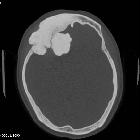Tumors of the base of skull (differential diagnosis)


























Tumors of the base of skull are histologically varied and are often challenging to preoperatively diagnose and treat.
Exactly which tumors are considered to be tumors of the base of skull is debatable. The broadest definition would include any tumor that involves or abuts the base of skull, thus including pituitary tumors and many tumors of the posterior fossa and cavernous sinus. On the other hand, a very narrow definition would be limited to those tumors that arise from the bones and connective tissues that form the skull base.
Pragmatically, it is sometimes not possible to distinguish between lesions that arise from bone and cartilage and those that secondarily involve them after originating within the cranial cavity or in the upper neck and paranasal sinuses. In addition, numerous conditions that can mimic tumors can also be encountered and need to be considered on a differential.
What is presented below is, therefore, a fairly broad differential list divided into conditions that can occur anywhere in the skull base and then lesions that are usually only seen in one region .
All regions
The following entities can involve all parts of the base of skull and thus should be included in all regions.
- arising from or in bone and cartilage of the base of skull
- arising from the intracranial compartment but involving bone
- arising from the soft tissues below the base of skull but involving bone
- sarcomas (e.g. rhabdomyosarcoma)
- infection (e.g. fungal)
Central skull base
Although the central base of skull is generally considered part of the middle cranial fossa and forms a relatively minor component of the whole skull base it has numerous tissue types and complex anatomy and embryology. It is therefore worth considering separately. In addition to most of the aforementioned lesions that can occur anywhere, numerous entities are only found in this location.
- arising from or within bone and cartilage of the base of skull
- arising from the intracranial compartment but involving bone
- pituitary macroadenoma
- craniopharyngioma
- schwannomas of cranial nerves within the cavernous sinus
- giant internal carotid artery aneurysm
- cavernous sinus hemangioma
- arising from the soft tissues below the base of skull but involving bone
- nasopharyngeal carcinoma/sinonasal carcinoma
- mucocele
- perineural extension of head and neck tumors (e.g. adenoid cystic carcinoma, squamous cell carcinoma)
Anterior cranial fossa
The anterior cranial fossa extends from the frontal sinuses back to the sphenoidal ridge and planum sphenoidale. In addition to most of the lesions that can occur anywhere, a few lesions are typical of this location.
- arising from soft tissues below the base of skull but involving bone
- sinonasal carcinoma
- esthesioneuroblastoma
- juvenile nasopharyngeal angiofibroma
- tumors of the orbit
Middle cranial fossa
The middle cranial fossa extends from the sphenoidal ridge anteriorly to the petrous ridge posteriorly. Medially it encompasses the central base of skull discussed above. Clinically it is helpful to think of the central base of skull and lateral middle cranial fossa as distinct. In addition to most of the lesions that can occur anywhere, a number of lesions, particularly those from the middle ear and inner ear, can involve this region.
- arising from or within bone and cartilage of the base of skull
- middle ear and inner tumors/masses
- infection e.g. petrous apicitis and necrotizing otitis externa
- arising from the intracranial compartment but involving bone
- schwannomas of cranial nerves (e.g. trigeminal schwannoma)
- arising form soft tissues below the base of skull but involving bone
- direct extension from parotid tumors
Posterior cranial fossa
The posterior fossa is located posterior to the petrous ridge laterally and the spheno-occipital synchondrosis in the midline. In addition to most of the aforementioned lesions that can occur anywhere, a few additional lesions should be considered.
- arising from or within bone and cartilage of the base of skull
- arising from the intracranial compartment but involving bone
- schwannomas of cranial nerves (e.g. vestibular schwannoma)
Siehe auch:
- Meningeom
- Fibröse Dysplasie
- Tumoren der hinteren Schädelgrube
- Nasopharynxkarzinom
- Chondrosarkom der Schädelbasis
- Meningeom vordere Schädelgrube
- inflammatorischer Pseudotumor der Schädelbasis
- Ewingsarkom der Schädelbasis
- Garcin-Syndrom
- skull base chordroma
- glandular epithelioma of the maxillary sinus with extension to the anterior and central skull base
und weiter:

 Assoziationen und Differentialdiagnosen zu Tumoren der Schädelbasis:
Assoziationen und Differentialdiagnosen zu Tumoren der Schädelbasis:




